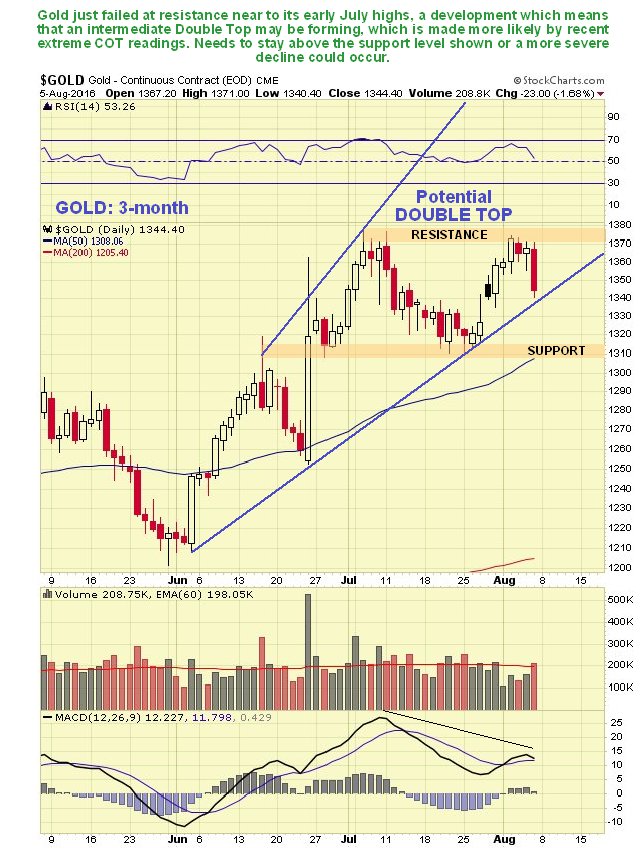Stocks & Equities
We are currently experiencing a “Kondratiev Winter” stage in this stock market which is at its’ “tipping” point. This is where nominal to incremental highs on the SPX can be exceeded by 2%, but, by no more than 4%. I am observing a “MARKET FAILURE” right here and now. This is a BULL TRAP!
Last Fridays’, August 5th, 2016 rally in the SPX big price move, on low volume, resulted in no trend change to the larger BEARISH patterns. It does not change the Bearish pattern, but it probably does mean that the current rally will last for at least a few more days. There are multiple times in which rallies are reversed during the early part of the following week after a strong jobs report.
Both investors and traders continue to throw money at stocks every time that there is any hint of “manufactured” good news. The majority of stocks, on the NYSE, are still in ‘downtrends’. Last Friday, August 5th, 2016, the Bureau of Labor Statistics released their “bogus” jobs report claiming that 255,000 new jobs were created.
This strong number caused gold to drop sharply, which momentum traders could have profited handsomely if they knew about the rouge price spikes taking place in gold just hours before the move.
The labor participation rate rose a mere 0.2 percent to 62.8 percent which is at a 40 year low. This means that potentially over 90 million Americans are still not working.
After adding only 11,000 jobs, in May of 2016, the Bureau of Labor Statistics would have the public believe that the US has now added over 550,000 jobs, in the sixty-day period, since. I find these numbers still hard to believe. There is no actual evidence of this having occurred:
It is all just a statistical adjustment as well as the “seasonal adjustment” factor as mentioned by Zero Hedge.
Over the past 120 years, within in a 7-year bull market, it is during the Fall season of the 7th year when the next major decline commences. The SPX is putting in its’ final TOP. It will become a well-defined top that usually cannot exceed a 2% to 4% throw over.
We are currently witnessing an extremely aged and overvalued bull market. The SPX Index, despite the exuberance of “record highs,” is just 2% above its’ May 2015 peak. The SPX has pushed it to its’ most extreme overvalued, overbought and over bullish syndrome in an environment where momentum is slowly rolling over. Whether one is bullish or bearish, one needs to recognize that any current extremes are “unparalleled”.
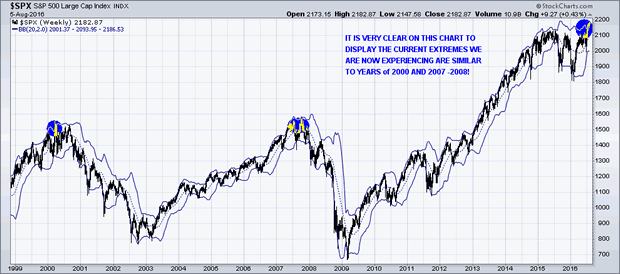
Statistically speaking, the single most probable outcome is actually a small gain which we have experienced and which is then followed by abrupt and severe losses that can have the potential of wiping out weeks or even months of upside progress with an unexpected and rapid decline.
I will have to wait for the market sentiment to shift toward “risk-aversion”, before participating in any long-term bearish ETF trades. Within an increased global systematic world, both investors and traders are making “risky and unparalleled” bets, these days.
I can visualize the financial meltdown. Many financial entities will have lower profits since low interest rates persist. Historically, low yields squeeze the net interest income of banks and make liabilities harder to meet for insurance companies. I would cut their EPS forecasts by 5%-7%. The fall in Treasury yields explains most of the cut. Their strong headwind is headed our way.
Sell into These Rallies:
If you are still in the stock market, I continue to recommend to sell stock positions into the rallies.
Chart End of July 31st, 2016
Take a look at the stock index outflows in July. This shows money continues to leave the leading indicator stocks (Russel 2k, and the Nasdaq).
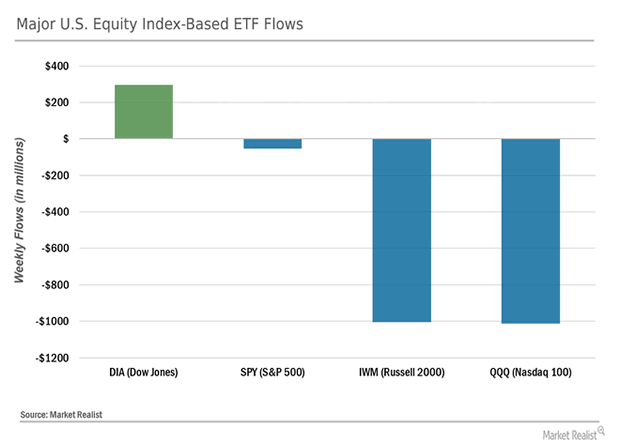
CNN Chart of Fear and Greed August 6th, 2016
Now, take a look at the fear index. While I personally use a slightly different mix of indicators to measure market sentiment, this is very close to my calculation and shows it in a simple visual format.
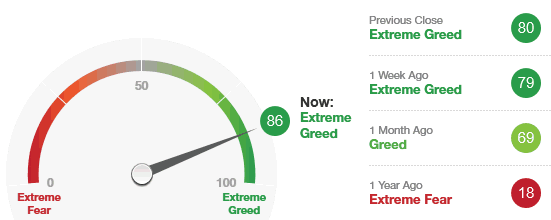
Conclusion:
With all of the “Extreme” complacently and the “Extreme” greed in the stock market, it is the perfect storm for DISASTER!
With that said, nothing happens exactly when it should in the stock market. The market is constantly trying to get the mass of participants on the wrong side of the market. If it doesn’t shake you out, it will wait you out and I feel it’s doing the later method now.
….also from Chris: Stocks Will Have a ‘Waterfall Decline’ and Silver Will ‘Skyrocket’ in August!

Here comes BIG trouble. Increasingly it has become evident in the USA that both the Democrats and Republicans are threatening to “renegotiate” Free Trade. The uncertainty alone will create big negatives in our economy. If it ultimately takes place, strap in for a very rough ride.
…also from Michael: Look Out Below!!! This is the Financial Time Bomb That’s Going To Nail All Of Us


 Table of Contents:
Table of Contents:
- Weekly Blog Post: What Was Your First Real Lesson in Leadership? Here’s Mine.
- Business Tip of the Week: A specific action you can implement immediately.
- Ask Eamonn: Each week I answer subscriber questions.
- Top 3 Trending: Business stories of the week.
- Events: My speaking, panels and other events.
My First Real Lesson in Leadership
In 1986, I had just graduated from engineering school with my newly-minted diploma, $30,000 in debt (1986 dollars), with no immediate prospects for employment. Two years previously, I had driven across the country from Vancouver sleeping in a car I had purchased for $55, as the result of placing 30 simultaneous stink bids on surplus auction vehicles, and blew a piston only 50 km from the school forcing me to hitchhike the rest of the way to start my studies.
As a new graduate, I made my way to Toronto, determined to kick-start my career. After only two weeks, I was fortunate to land a job with the Ford Motor Company (Electronics Division) as a Midnight Shift Production Supervisor, at their 1,400 person advanced automotive electronics manufacturing facility in Markham, Ontario. When I arrived at 11:00 pm on a Sunday night to supervise my first shift, I was surprised and slightly horrified to find that I was responsible for directly supervising 85 production line workers, most of whom were twice my age and who had seen young, eager engineers like me come and go many times. This was definitely not an experience I had prepared for, however, I made one very important decision at the beginning of my shift that night, which enabled me to be successful in that role and then helped catapult my career at Ford and other companies.
I decided that rather than trying to dazzle all 85 people with my brilliance at recently acquiring an electrical engineering degree (good luck!), I would do one simple thing – connect with each person as an individual! I thought the best way I could make that one-on-one connection would be to learn first and last names of each person by the end of the week. So, for the 5 days, I would appear on the shift as the “Supervisor” but in reality, they were tolerating my presence and supervising me while deciding if I was worthy of leading them, and if I could stay or go. Meanwhile, each night I would take out a piece of paper on which I had drawn a map of the production line with the corresponding first and last names of each person. I proceeded to try any tactic I could memorize their names, such as using it repeatedly in a conversation like some Dale Carnegie Seminar on steroids. To my utter astonishment, I very quickly learned each name and gained their confidence and respect. After nine months in this role, and showing respect for the people that worked for me, my hard-boiled manager, who himself had started on the production line, saw potential in me and moved me onto roles with greater leadership responsibility.
My first real lesson in leadership was complete. I learned that if you do the small things well for people, they will trust you with the big things. I learned that leadership is about the respect we have for others in the little things we do, so we earn the right to be part of someone’s life, not be granted the right to manage his or her world. I learned it’s about having the courage to do something hard when everybody is watching and success is not a guarantee. It’s about the degree of caring we show for others, as human beings, not as colleagues, co-workers, associates or employees. I learned that business is about people, first and foremost.
By Eamonn Percy
Business Tip of The Week:
To connect with people, take the time to show you care by making the effort to get to know them, their hopes and dreams, and in return, they will care about you.


![]()
In This Week’s Issue:
- Weekly Commentary
- Strategy of the Week
- Stocks That Meet The Featured Strategy
Stockscores Market Minutes Video – Beware of Stock Tips –
Many people rely on stock tips for their trading ideas but there are many problems with this approach. This week I discuss why you should be very cautious with stock tips and then provide my weekly market analysis. Click Here to Watch To get instant updates when I upload a new video, subscribe to the Stockscores YouTube Channel
Trader Training – Why It Does Not Pay to Be Informed
In theory, information should make the stock market’s world go round. Information about companies and their ability to make money in the future is what should determine share price. As the market learns of new information, price is adjusted up and down to reflect the value of that information.
This implies that investors should focus their analysis on information so they can predict where share prices should go in the future.
While this makes good sense, I have found it to be extremely rare that investors who use information are able to consistently beat the stock market. With smaller retail investors (you and I) in particular, the use of information for making investing decisions is more destructive than it is beneficial. Here are ten reasons why:
1. Information is Usually Already Priced In – most investors use publicly available information. That means it is widely known and available to anyone considering the stock. If information is available to a large number of investors then we should expect that the market will have priced that information in to the stock. Therefore, the information has not value to us.
2. Information Usually Comes with a Bias – as a general rule, people do what they are financially motivated to do. If someone is encouraging you to purchase a stock, there is a good chance that they have some financial motivation to do so. Before you trust the information you receive, understand the financial motivation. If you find the reason, you will often usually find that there is a strong bias in the information being provided to you.
3. Trading on Truly Insider Information is Illegal – there are few risk free trades in the stock market, but trading on significant, inside information is one. You stand to make a lot of money buying stock in a company that will be acquired by another at a premium tomorrow. If you have that information and act on it, you are trading on inside information and that can land you in jail.
4. Gathering Good Private Information is Expensive and Time Consuming – there are investors who are able to uncover information that is not priced in to a stock but is not considered inside information. This private information is valuable because it can lead to market beating returns. However, gathering private information typically requires significant resources, knowledge and time. For small investors, it is not feasible to do this kind of work across a broad range of stocks.
5. Information Causes You to Ignore the Market’s Message – when you have an understanding of a company’s story, there is a tendency to fall in love with that story and ignore new information that goes against your outlook for the stock. This leads the committed shareholder to hang on to a losing position, allowing the loser to bog down the performance of the overall portfolio.
6. You May Not Have All of the Information You Need – the market tends to focus on two or three key information points that affect the price investors are willing to pay for it. An investor who does a thorough fundamental analysis of the stock may still have an incomplete understanding of the company’s business. If missing one of the key points, this investor can make a gross error in valuing the stock.
7. The Market May Not Be Trading On Fundamentals – in theory, stock price is based on the present value of future earnings expectations. In practice, there are often very non fundamental influences on share price. A large investor that has a liquidity crisis may be forced to unload a large position with little regard for price. Often, the laws of supply and demand affect share price even though theory tells us that they should not have an influence.
8. Your Interpretation May Not Be the Same as The Market’s – Our mood affects how we judge information and the same can be said for the market in general. Your fundamental analysis may be correct in an optimistic environment, but if the market is in a pessimistic mood, the investment can lead to losses. Even the market is wrong, it is right.
9. There Is No Standard for What Information is Worth – There are many formulas for determining what a company’s share price should. Many fundamental analysts look for stocks to trade at a certain multiple of their earnings with that multiple to be based on growth. However, there are great variations in accounting methods that can have a profound effect on how earnings are reported. More importantly, there is no rule that a company should trade at a certain multiple of earnings, that target multiple is just an opinion.
10. We Tend to Focus On Information That is Easy to Get – we often look for the easiest way to achieve a goal. With information, there is a tendency to focus on the information that is front of us. Rather than work to find something to disprove our thesis on a stock, we instead look for information to strengthen our thesis. In doing so, we present our own biased outlook for our investment decisions that can often be very incomplete and wrong.
Ultimately, I look at the market’s interpretation of all available information when I look at a chart of price and volume. It shows not only every bit of information detail but also what the market thinks of it.
This morning, I ran the Morning Movers CDN Market Scan in search of stocks with good daily and weekly charts for longer term position trades. Energy dominated the list of candidates, here are two that have good three year charts.
1. T.ERF
T.ERF has been strong for a few months but stalled its upward trend over the past month. Looks to be resuming the trend with a cup and handle pattern break on the weekly chart. Support at $7.50.

2. T.PSK
T.PSK is breaking through resistance from an optimistic rising bottom pattern after breaking the downward trend line. Support at $24.80.
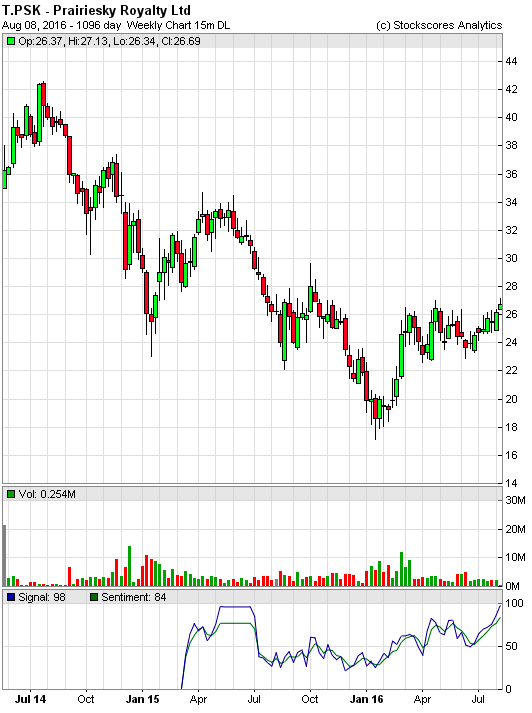
Alert: Don’t miss Michael’s great interview with the highly regarded Greg Weldon: On The Brink of Soaring Move In Gold & Silver
References
- Get the Stockscore on any of over 20,000 North American stocks.
- Background on the theories used by Stockscores.
- Strategies that can help you find new opportunities.
- Scan the market using extensive filter criteria.
- Build a portfolio of stocks and view a slide show of their charts.
- See which sectors are leading the market, and their components.
Disclaimer
This is not an investment advisory, and should not be used to make investment decisions. Information in Stockscores Perspectives is often opinionated and should be considered for information purposes only. No stock exchange anywhere has approved or disapproved of the information contained herein. There is no express or implied solicitation to buy or sell securities. The writers and editors of Perspectives may have positions in the stocks discussed above and may trade in the stocks mentioned. Don’t consider buying or selling any stock without conducting your own due diligence.




